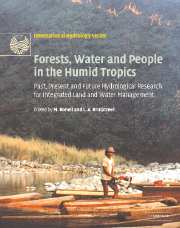 Forests, Water and People in the Humid Tropics
Forests, Water and People in the Humid Tropics from Part III - Forest disturbance, conversion and recovery
Published online by Cambridge University Press: 12 January 2010
INTRODUCTION
Fire has always been apparent to some extent in humid tropical forest as an agent of disturbance leading to forest renewal through succession and even to long-term changes in the biome (Flenley, 1979; 1992; 1998). Under climatic conditions of occasional drought there is an element of natural forest fires occurring without human interference (Goldammer, 1992) although this is difficult to establish because the use of fire also links back to the earliest forms of agriculture (Boserup, 1965; Steensberg, 1993). Today however, the role of man is more evident than ever before in understanding the dynamics of fire, humans and vegetation ecology (Uhl, 1998).
Perceptions by lowlanders of a loss of ‘forest catchment functions’ due to ‘upland shifting cultivators’ are often strong but these may not be based on a clear understanding of the cause-effect chains involved. For example, most major and capital cities in South East Asia have been built on floodplains at the mouths of rivers, i.e. in areas where occasional flooding is to be expected regardless of the forest cover of the uplands (Hamilton and King, 1983). When floods do occur, however, land use change in the uplands provides an easy scapegoat, especially if the uplanders have a different ethnic and cultural background, as for example in Northern Thailand. These conflicts over land use change in the uplands have reached such an intensity in some areas that basic research findings are not likely to modify the perceptions and standpoints of different stakeholders in the conflict (Van Noordwijk, pers. obs.).
To save this book to your Kindle, first ensure no-reply@cambridge.org is added to your Approved Personal Document E-mail List under your Personal Document Settings on the Manage Your Content and Devices page of your Amazon account. Then enter the ‘name’ part of your Kindle email address below. Find out more about saving to your Kindle.
Note you can select to save to either the @free.kindle.com or @kindle.com variations. ‘@free.kindle.com’ emails are free but can only be saved to your device when it is connected to wi-fi. ‘@kindle.com’ emails can be delivered even when you are not connected to wi-fi, but note that service fees apply.
Find out more about the Kindle Personal Document Service.
To save content items to your account, please confirm that you agree to abide by our usage policies. If this is the first time you use this feature, you will be asked to authorise Cambridge Core to connect with your account. Find out more about saving content to Dropbox.
To save content items to your account, please confirm that you agree to abide by our usage policies. If this is the first time you use this feature, you will be asked to authorise Cambridge Core to connect with your account. Find out more about saving content to Google Drive.